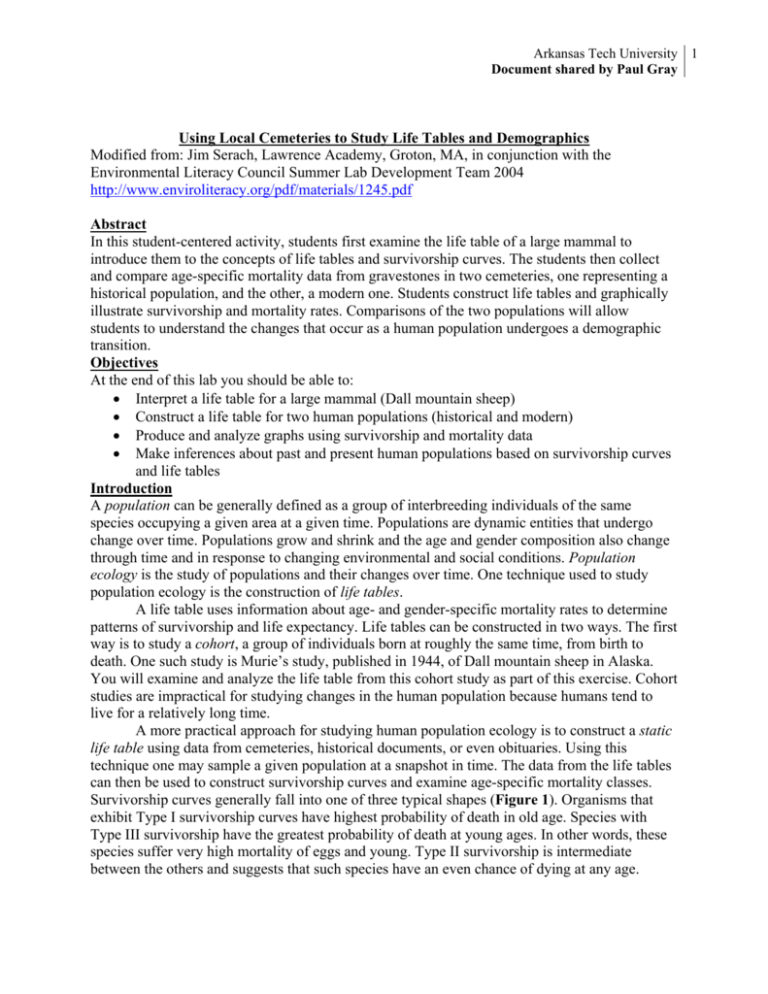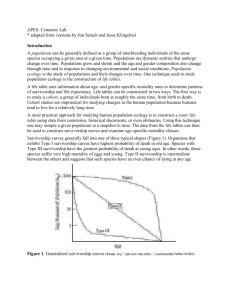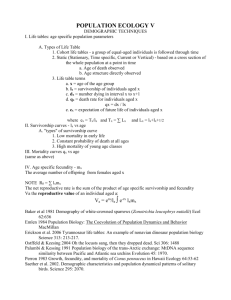Using Local Cemeteries to Study Life Tables and Demographics
advertisement

Arkansas Tech University 1 Document shared by Paul Gray Using Local Cemeteries to Study Life Tables and Demographics Modified from: Jim Serach, Lawrence Academy, Groton, MA, in conjunction with the Environmental Literacy Council Summer Lab Development Team 2004 http://www.enviroliteracy.org/pdf/materials/1245.pdf Abstract In this student-centered activity, students first examine the life table of a large mammal to introduce them to the concepts of life tables and survivorship curves. The students then collect and compare age-specific mortality data from gravestones in two cemeteries, one representing a historical population, and the other, a modern one. Students construct life tables and graphically illustrate survivorship and mortality rates. Comparisons of the two populations will allow students to understand the changes that occur as a human population undergoes a demographic transition. Objectives At the end of this lab you should be able to: • Interpret a life table for a large mammal (Dall mountain sheep) • Construct a life table for two human populations (historical and modern) • Produce and analyze graphs using survivorship and mortality data • Make inferences about past and present human populations based on survivorship curves and life tables Introduction A population can be generally defined as a group of interbreeding individuals of the same species occupying a given area at a given time. Populations are dynamic entities that undergo change over time. Populations grow and shrink and the age and gender composition also change through time and in response to changing environmental and social conditions. Population ecology is the study of populations and their changes over time. One technique used to study population ecology is the construction of life tables. A life table uses information about age- and gender-specific mortality rates to determine patterns of survivorship and life expectancy. Life tables can be constructed in two ways. The first way is to study a cohort, a group of individuals born at roughly the same time, from birth to death. One such study is Murie’s study, published in 1944, of Dall mountain sheep in Alaska. You will examine and analyze the life table from this cohort study as part of this exercise. Cohort studies are impractical for studying changes in the human population because humans tend to live for a relatively long time. A more practical approach for studying human population ecology is to construct a static life table using data from cemeteries, historical documents, or even obituaries. Using this technique one may sample a given population at a snapshot in time. The data from the life tables can then be used to construct survivorship curves and examine age-specific mortality classes. Survivorship curves generally fall into one of three typical shapes (Figure 1). Organisms that exhibit Type I survivorship curves have highest probability of death in old age. Species with Type III survivorship have the greatest probability of death at young ages. In other words, these species suffer very high mortality of eggs and young. Type II survivorship is intermediate between the others and suggests that such species have an even chance of dying at any age. Arkansas Tech University 2 Document shared by Paul Gray Dall Sheep Procedure 1. Examine the data table (Figure 2). Complete the Analysis exercises. Cemetery Procedure NOTE: It is very important to remember that cemeteries are sacred places. Please do not act disrespectfully or disturb the gravesites or monuments. Be especially considerate if other people are visiting the cemetery. 1. Go to section of the cemetery that your group is studying. You will look at every legible gravestone in the area. Tell your teacher when you have finished but do not move to another area of the cemetery until you are instructed to do so. 2. One person in the group will be the recorder. His or her job is to record the data called out by the other group members, who are the data collectors. Label your data sheet with your names and the population you are observing (historical or modern) 3. Record the gender of the deceased and age at death on the field tally sheet. Total each age interval in each gender. Lab Tips The best way to collect the information is for the data collectors to call out to the recorder that age and sex of the deceased. The recorder should put tally marks on the data sheet in the proper age interval. Data/Observations Your data will be used to determine age-specific mortality and construct life tables and survivorship curves for historical and modern human populations in a given area. You can then make comparisons between groups and make inferences about the populations studied. Arkansas Tech University 3 Document shared by Paul Gray Figure 1. Generalized survivorship curves (From: http:// jan.ucc.nau.edu/.../ Lectures/lec14/lec14.htm) Ageinterval(years) 0-1 1-2 2-3 3-4 4-5 5-6 6-7 7-8 8-9 9-10 10-11 11-12 12-13 13-14 14-15 Number dying during age interval 121 7 8 7 18 28 29 42 80 114 95 55 2 2 0 Survivorship (Number surviving at beginning of age interval) 608 487 480 472 455 447 419 390 348 268 154 59 4 2 0 Number surviving as a fraction of newborn (lx) Mortality rate (mx)* 1.000 0.801 0.789 0.776 0.764 0.734 0.688 0.640 0.571 0.439 0.252 0.096 0.006 0.003 0.000 0.199 0.014 0.017 0.015 0.039 0.063 0.069 0.108 0.230 0.426 0.671 0.933 0.500 1.000 n/a Figure 2. Life table for the Dall mountain sheep (Ovis dalli). The age of death was recorded for 608 sheep observed in Denali National Park, Alaska, by Olaus Murie (1944). (Adapted from: Ricklefs, R. 1973. Ecology. Chiron Press) * Annual mortality rate, calculated as the ratio of the number dying during an age interval to the number surviving at the beginning of that age interval. For example, the mortality rate for the age interval 8-9 years is 80 deaths/348 individuals = 0.230 (23 % per year). Arkansas Tech University 4 Document shared by Paul Gray NAME______________________________ Using Local Cemeteries to Study Life Tables and Demographics Prelab Reading Questions 1. What is a demographic transition? (look it up.) 2. Why do populations grow and shrink and the age and gender composition also change through time? 3. How does a cohort study differ from a static life study? 4. Contrast the three shapes of survivorship curves. (read the textbook.) 5. Summarize the procedure we will use in the cemetery procedure. Arkansas Tech University 5 Document shared by Paul Gray Dall Sheep Analysis Exercises 1. Is this a cohort study or a static life study? 2. What does a high mortality rate mean? 3. What trends or patterns are evident in the data? 4. Construct a survivorship curve by plotting age class midpoint (x-axis) versus number Surviving at the beginning of the age interval (y-axis). (Figure 2) 5. What survivorship curve is a best fit for these data? Cemetery Analysis Exercises 1. Using Excel, construct a data table for the historical group. Construct another table for the modern group. Create Line graphs comparing male and female survivorship for both groups. Print out the two (2) data tables and the two graphs and attach them to these worksheets. 2. Compare the mortality data for the historical group and the modern group. 3. Examine the graphs. Which graph better allows a direct comparison of the data. Splain. 4. Are there gender differences in survivorship in either population? Splain. 5. How do the differences in survivorship affect the potential for population increase? 6. What explanations can be given to account for any differences or similarities in survivorship and mortality rates observed among the populations? 7. Do these data indicate a demographic transition? Splain. 8. What are some things that you still do not know at the end of this lab? In other words, what are some new questions that have been generated by the study? How would you go about finding out the answers? Arkansas Tech University 6 Document shared by Paul Gray Historical Group Age Class Female (midpoint) Deaths 2.5 7.5 12.5 17.5 22.5 27.5 32.5 37.5 42.5 47.5 52.5 57.5 62.5 67.5 72.5 77.5 82.5 87.5 92.5+ Total Male Deaths Modern Group Age Class Female (midpoint) Deaths 2.5 7.5 12.5 17.5 22.5 27.5 32.5 37.5 42.5 47.5 52.5 57.5 62.5 67.5 72.5 77.5 82.5 87.5 92.5+ Total Male Deaths Arkansas Tech University 7 Document shared by Paul Gray Cemetery Data Tally Sheet Location _______________________ Group __________________ Date ____________ Age Class 0-4.9 5-9.9 10-14.9 15-19.9 20-24.9 25-29.9 30-34.9 25-39.9 40-44.9 45-49.9 50-54.9 55-59.9 60-64.9 65-69.9 70-74.9 75-79.9 80-84.9 85-89.9 90+ Female Tally Female Total Male Tally Male Total








